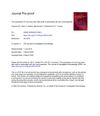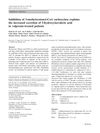Search
forLearn
5 / 16 resultslearn Neem Oil
natural substance from Neem tree with medicinal and pesticidal properties
learn Finasteride
Frontline, gold standard treatment for combatting androgenic alopecia
learn Dutasteride
Heavy duty finasteride that comes with higher risks, but scalp injections seem safe and are gaining popularity
learn HMI-115
much-hyped research compound targeting prolactin receptor in scalp
Research
5 / 1000+ results
research Novel ABCD1 Gene Mutation in Adrenomyeloneuropathy with Hypoplasia and Agenesis of the Corpus Callosum
Researchers found a new ABCD1 gene mutation linked to a rare brain and nerve disorder with unusual brain changes.

research The Suppression of Very Long Chain Fatty Acids Is Associated with Skin Carcinogenesis
Suppressing very long chain fatty acids is linked to skin cancer.
research Very-Long-Chain Acyl-CoA Synthetases
Very-long-chain acyl-CoA synthetases and fatty acid transport proteins play key roles in fatty acid metabolism and lipid processing in different tissues.

research Perturbations in Fatty Acid Metabolism and Collagen Production Infer Pathogenicity of a Novel MBTPS2 Variant in Osteogenesis Imperfecta
A new MBTPS2 gene variant disrupts fat metabolism and collagen production, causing Osteogenesis imperfecta.

research Inhibition of 3-Methylcrotonyl-CoA Carboxylase Explains the Increased Excretion of 3-Hydroxyisovaleric Acid in Valproate-Treated Patients
Valproic acid treatment increases a specific acid in urine by blocking an enzyme, possibly causing skin rash and hair loss.
Community Join
5 / 1000+ resultscommunity Fats on your Head to Stop Hair Loss?
The conversation discusses the potential of long-chain unsaturated fatty acids, like oleic and linoleic acid, as an additional treatment for hair loss, which may inhibit the enzyme responsible for converting testosterone to DHT and promote hair growth. Users humorously suggest using oils topically and discuss other hair loss treatments, but the main focus is on the science behind fatty acids and their role in hair health.
community DHT Harms Scalp Microbiome: DHT Itch is REAL
Increased Malassezia and Cutibacterium in the scalp microbiome are linked to higher sebum production and inflammation in androgenetic alopecia (AGA). Treatments include ciclopirox shampoo, benzoyl peroxide shampoo, clobetasol propionate, calcipotriol, minoxidil, finasteride, and dutasteride.

community Compressed part of research of theory of androgenic/anabolitic balance. AGA h-responders analytic. Theory of physio-metabolitic method of anti AGA treatment
The treatment for androgenetic alopecia involves using finasteride and minoxidil with intense exercise and cold exposure to boost metabolism and reduce androgenic effects, potentially leading to hair regrowth. This approach may activate biological pathways for improved hair and overall health.
community I am actually regrowing my hairline without minoxidil or finasteride (mechanical stimulation)
Regrowing hairline without the use of Minoxidil or Finasteride, and instead using mechanical stimulation such as Derma Roller, Nizoral, Zinc Pyrithione, Scalp Massage, Scalp Exercise, Fish Oil and other topical solutions. It is cautioned that there are risks associated with not using medically-prescribed treatments, but it is suggested to consider mechanical stimulation in addition to those prescribed treatments.
community Hair Remedies that Don't Work for Anybody Seeking Hair Regrowth
Hair loss treatments discussed include minoxidil, finasteride, and RU58841. Salon products and supplements generally don't work for hair regrowth unless there's a severe nutritional deficiency, while hormonal treatments like estrogen and spironolactone can be effective.